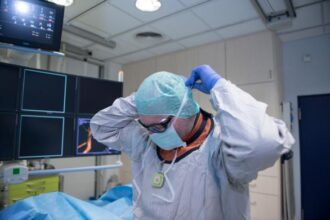Novadaq Technologies (TSX:NDQ) President & CEO Arun Menawat was interviewed by OneMedRadio. Novadaq was founded in 1992, and now has 76 Employees and $153 Million Market Cap. The 12 month trading range is $2.72 – $5.39. As of July 15th 2011 the stock price was at $4.70.
Transcript of Interview:
Novadaq Technologies (TSX:NDQ) President & CEO Arun Menawat was interviewed by OneMedRadio. Novadaq was founded in 1992, and now has 76 Employees and $153 Million Market Cap. The 12 month trading range is $2.72 – $5.39. As of July 15th 2011 the stock price was at $4.70.
Transcript of Interview:
Brett Johnson: Welcome from New York, this is Brett Johnson with OneMed Radio. Today, we are with Arun Menowat who is the CEO of Novadaq. Novadaq is a Toronto-based medical imaging company that serves the surgical suite. The company is traded as NDQ on the Toronto Stock Exchange. Thanks for joining us today, Arun.
Arun Menowat: Thank you.
Brett Johnson: So, Arun, for our listeners, can you give us sort of a broad overview of Novadaq Technologies and where you guys came from and what you do?
Arun Menowat: Sure. We have a unique imaging technology that is designed to be used by surgeons specifically in complex operating procedures. What our technology allows us to do is help visualize blood flow in various blood vessels, but also in microvessels so that surgeons can assess perfusion in tissue or in organs. In turn, what this allows them to do is make much, much better decisions as they are cutting different parts of the body and thereby, you know, improve the clinical outcomes of these complex procedures. Why is that important, it’s because that’s where really the cost is in healthcare, is these complex procedures can cost a lot of money and, you know, we have a number of case studies that actually show that improved clinical outcomes reduces cost significantly.
Brett Johnson: So in terms of the product itself and how it gets to the market, you are in a relationship with Intuitive Surgical, is that correct?
Arun Menowat: As I mentioned, our technology applies to multiple types of procedures. So our business strategy is to really partner with market leading companies and we actually have two partnerships. One of them is with Intuitive Surgical for Robotic Procedures and in this partnership, our product is essentially integrated with the da Vinci Robotic System and they’ve actually started a limited launch in February after the FDA clearance. The second partnership is in plastic surgery with Live Cell, which is the market leading company in plastic surgery and interestingly enough, they also did their market launch in February of this year.
Brett Johnson: Interesting. So arguably, these are two of the leading companies in the market today that have selected your technology essential to their equipment, is that correct?
Arun Menowat: Yes, absolutely. And, you know, in 2009 and 2010, we were more of a market development phase. But this year because of these partnerships, we are really at that inflection point we had announced at the last Analyst Call that we expected to ship at least 70 systems and that’s because of these market leading companies that have really gotten off to a pretty good start.
Brett Johnson: And are those systems in the US or is that domestic or is that international or what’s sort of the scope of the business?
Arun Menowat: Well right now, you know, our primary focus is really US. We have been getting quite a bit of attention from the international markets also and we are evaluating our international strategies, but our primary goal right now is to really drive adoption in the US.
Brett Johnson: So is it that Life Cell essentially and Intuitive in two years have started developing these relationships, getting the technology followed, and now you’re expecting to see some good results as a result of their beginning to market these technologies, to market their devices rather?
Arun Menowat: As you know, in life sciences we’re constantly working on clinical data at new applications and at this point, we have over 40 publications and peer-reviewed journals. We have case studies, as I mentioned, on how clinical outcomes can be improved and how cost can be reduced. Both of these partners are now introducing the products. We have also garnered the attention of key market, key opinion leading surgeons and so our product is — you know, I think in plastic surgery for example, we have among the top 50 leading hospitals such as Stanford University or MD Anderson or Duke, you know, big name universities are now using our product pretty much as a standard already. Intuitive has begun marketing it in solid organ cancer removal applications such as partial nephrectomies. There are some interesting videos out there already that are demonstrating the value of the product. So, you know, we’re in that, I guess in my mind, what I call the second phase of early adoption essentially.
[0:05:36]
Brett Johnson: Can you talk a little bit about sort of the top line revenue that both Intuitive and Life Cell are expecting or are generating in terms of their rollouts and can you give us sort of guidance on sort of what that means or would mean for Novadaq if they’re successful in their selling efforts?
Arun Menowat: We have not provided revenue guidance so far. What we have said is that our current revenue run rate is about $12 million a year and we anticipate that our operating costs will remain relatively stable and that perhaps in the neighborhood of in the mid 20s revenues that we could be at a breakeven point. So we’ve done, you know, a pretty good job of managing our cost and structuring the business with good potential margins in the range of 50% or higher. The markets that these companies are in are significant in size so I think that as the adoption goes, the potential to get into, you know, revenues that are significantly above those numbers is quite high. And the other thing that we have said publicly is that we think that these partners are placing about 70 systems so the range of 50 to 75 systems a quarter is probably a good range to consider as we go forward.
Brett Johnson: What does the system cost typically?
Arun Menowat: The business model is actually more of a pay-per-click business model. So in the case of Live Cell for instance, they place the device for a minimum commitment of usage and on the basis of that use, we get paid a certain percentage of the revenues.
Arun Menowat: In the case of Intuitive Surgical, it’s a little bit of a different model because they do get capital upfront so when we ship our modules to them for the integration, we get paid for those modules and then as the product gets used, we will get paid on a per patient basis as well.
Brett Johnson: As you look down into this coming year, what do you see as the key milestones for Novadaq?
Arun Menowat: As I mentioned, the inflection point is critical to us. So continuing to drive new shipments, you know, in the coming next two to three quarters at least moving forward is a key milestone worth watching. The second one is that, as you know, we already have two agreements with two market-leading companies. We think that there’s at least one more on the horizon for us by the end of this year that could also be in a very interesting application. We think that the most likely would be in wound care, which would be for complex patients who are typically diabetic patients where we can help visualize and do surgical planning for the purpose of amputations or lack of reductions in those or for the purposes of wound care, wound healings in diabetic patients. Certainly, we think that we will continue to advance our clinical strategies and being able to begin some more multi-centered trial in the second half of this year would be another key milestone. Finally, we have a minimally invasive product that is in clinical work that we hope to announce our launch strategies, you know, sometime over the next 12 months.
[0:10:05]
Brett Johnson: And do you think the company will be going out for additional capital at any point in the coming year?
Arun Menowat: We actually raised some capital during the first quarter in March this year and we were delighted to have very strategic investors at that time as well as existing investors that came in. So at this point over the short term, we don’t foresee going back to the market for an equity raise.
Brett Johnson: Uh-hum. In terms of the stock price, how has it generally been trading? Can you talk a little bit about sort of the level of awareness about the stock and how it’s trading and what you sort of see as where the stock price could be in the coming year?
Arun Menowat: Sure. Brett, you know, I think from a historical perspective if you look at our stock from the 2009 period to where we are today, we are up at about 4x and that’s basically on the strength of the fact that the market development went well and the partnerships are coming along, are off to a good start. You know, I couldn’t predict where it would be. Certainly, this year, our stock has done well, continues to do well. What I think what is going on is that certainly we’re getting quite a bit of attention from investors in the US, although we are not listed in the US at this point. I think that the attention is likely to continue because they talk to our partners, they talk to hospitals, and they get independent feedback about our company and so certainly I think that is encouraging. I think, you know, as I’m sure most CEOs do think that the potential for our company is pretty strong and where the stock will go is hard to predict, but I certainly think from an operating point of view and profit potential point of view, I think it’s pretty strong.
Brett Johnson: Okay. Going down the road, what do you see as sort of the major hurdles or the challenges that the company faces in the coming months?
Arun Menowat: Those who know me, know that I worry about everything. And so I certainly think that we need to continue to train surgeons to the new technology that is certainly an important driver for us because we’re not like a pill where you can start to prescribe a different pill. This is, you know, relatively easy to learn how to use the instrument, but interpretation, peer-to-peer education, so surgeons training other surgeons, is certainly an important part of what is important for us. I think that continued attention to our clinical strategy is important, to continue to drive more and better clinical outcomes data is important. Continuing to drive the cost savings associated with it is another important thing for us to keep our eye on that.
Brett Johnson: Well it sounds very exciting. I mean certainly the relationship with Intuitive and with Live Cell really gives you I think an indication that you probably have about the best technology out there. Certainly, I think that offers — you know, it’s a very promising outlook so good luck to you in the coming year and we’ll certainly be interested to follow in the coming months.
Arun Menowat: Thank you so much, Brett.
Brett Johnson: Okay. We are with Arun Menowat who is the CEO of Novadaq Technologies, a Toronto-based surgical imaging company. The company is traded under NDQ in the Toronto Stock Exchange. Signing off from New York, it’s Brett Johnson from OneMed Radio.
[0:14:33]







